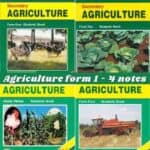AGRICULTURE ECONOMICS (BASIC CONCEPTS AND FARM RECORDS) NOTES
AGRICULTURE ECONOMICS (BASIC CONCEPTS AND FARM RECORDS)
This topic entails the following
- Definition of scarcity, preference and classic, opportunity cot as used in agriculture production.
- Uses of farm records
- Types of farm records i.e. production records, filed operation records, breeding records, feeding records, health, labour records and master roll.
- Define the term farm record.
- Documents kept in the farm showing various farm activities over a given period of time
- State two qualities of a good farm record
- Titled
- Neat
- Concise
- Complete
- Showing actual amounts
- Dated
- State four advantages of keeping up-to date labour records.
- To lay off unproductive labour
- Helps in budgeting
- To determine peak demand
- Helps to determine labour allocation
- Mention any three types of farm records that a farmer should keep
- Field operation records
- Production records
- Inventory records
- Marketing records
- Labour records
- Breeding records
- Workshop records
- Feeding records
- Health records
- a) Give four types of records that can be kept by a crop farmer.
- Field operation records
- Labour records
- Production record/ yield records.
- Account record.
Download more free unlimited Agriculture Resources Here:
AGRICULTURE SCHEMES OF WORK FORM ONE TO FOUR: UPDATED
Agriculture notes free pdf download (Form 1-4)
AGRICULTURE REVISION QUESTIONS AND ANSWERS F1-4
Agriculture KCSE Topical Questions and Answers Form 1-4 (All subjects)
FORM ONE FREE AGRICULTURE NOTES
AGRICULTURE KCSE REVISION BOOKLET: F1-4 QUESTIONS (EXAMS) AND ANSWERS

- b) Name two types of records a coffee farmer should keep.
- Labour records
- Production records
- Marketing records
- Field operation records
- Inventory records.
- Name the type of farm record from which each of the following information could be obtained
- i) Common livestock diseases occurring on a given farm
- Health records
- ii) Best fertilizer to use top dressing
- Field operation records
iii) The number of Jembes a farm owns
- Inventory
- iv) The sire used to obtain the calves on the farm
- Breeding records
- What is the importance of taking a farm inventory?
- In order to show what there is and what is not there in the farm / assist in detecting stolen items
- What are the uses of farm records to a farmer?
- Show the farmers assets and liabilities which help the farmer to know his net worth
- Provide history of the farm.
- Assist in planning and budgeting of various activities.
- Helps to detect losses or theft in the farm.
- Assists when sharing losses or profits (dividends / bonuses) for communal owned farms/ partnership.
- Help in settling disputes between heirs where there is no written will during succession
- Help to support insurance claim e.g. against fire and theft.
- Provide labour information like terminal benefits, NSSF due, Sacco dues for all employees.
- Help to compare the performance of different enterprises within a farm or other farms or between seasons
- Help in the assessment of income tax to avoid over or under taxation.
- Records, helps to show whether the farm business is making profit or losses. This information
- Used to obtain loan or credit facilities
- Identify the farm record below and the questions that follow:
| Date | Disease symptoms | Animals affected | Drug used | Cost of treatment | Remarks |
(a)Identity of the record
- Health record
(b) State two different information that should be entered in the remarks column
- Next date of treatment /vaccination
- Occurrence of the disease
- Response to treatment
(c) Give two importance of keeping the farm record illustrated above
- Select and cull animals on health ground
- Know the course of action to be taken in the event of a disease and maintenance of good health
- Know the prevalent disease
- Calculate cost of treatment
- Study the illustration below of farm records:- Use it to answer the questions that follow:
Enterprise —- Month——
| Name of cow | DAYS IN MONTH | |||||||||||
| 1 | 2 | 3 | 4 | 5 | 6 | |||||||
| AM | PM | AM | PM | AM | PM | AM | PM | AM | PM | AM | PM | |
(a) Name the type of the farm record illustrated above
- Milk production record
- b) Give three reasons for keeping health records in a livestock production
- Determine prevalent diseases;
- Establish treatment of diseases;
- Establish disease control method;
- Determine cost of medication/health care;
- Determine the health status of different animals;
(c) Give three pieces of information a dairy farm manager should collect for planning purposes
- Price trends/market situation
- Production techniques
- Labour trends
- Breeds of dairy cattle
- Production constraints/risks and certainties
- List down four pieces of information recorded in a field operation record.
- Field
- Area of the land /plot.
- Plot field no.
- Season
- Crop planted
- Crop grown/ variety
- Land preparation / Ploughing date
- Planting date
- Inputs used.
- Type of fertilizer at planting
- Type of fertilizer at top dressing
- Seed rate used
- Type of weed and date of weed control
- Diseases controlled/ method
- Type of pest and date of pest control
- Date of harvesting
- Yield
- Remarks
- a) Give two importance of keeping health records.
- Help in culling sickly animals (reject culling sick animals)
- Help in selection of animals for breeding
- Help in calculation of veterinary/ treatment cost
- Assist the farmer in knowing the prevalent diseases
- b) List four important entries in a health record.
- Disease ( type, name)
- Symptom (s)
- Drug used and the doctor, treating the animal
- Cost of treatment
- Remarks on response to treatment
- Animals identity affected
- Explain the following economic concepts:
(i) Scarcity
- Resource are limited in relation to the demand/where production resources are limited in relative to demand therefore a choice has to be made on which enterprises to allocate limited resources.
(ii) Preference
- One makes a choice according to his/her tastes/liking.
(iii) Opportunity cost
- The returns from the best alternative forgone.
- Under what conditions is opportunity cost zero?
- When the item is free.
- When the item is in plenty/ unlimited
- W hen there is no alternative
- Define the term Economics.
- Economics is the study of how man and society choose with or without the use of money to employ scarce productive resources which could have alternative uses to produce various commodities and services overtime and distribute them for consumption now and in future among various people and groups in society or
- Applied science carried at maximizing output at minimum costs through combining the limited supplies of land, capital, labour and management to produce goods and services for use in a given period of time
- What is opportunity cost in agricultural economics?
- Is the value of best alternative foregone
- b) A farmer has a piece of land on which he can produce maize and barley. The yield and selling prices of the crops are as shown below.
| Enterprise | Yield ( 90kgs bags) | Selling price ( KShs/90kg bag) |
| Maize | 2500 | 800 |
| Barley | 2000 | 1500 |
The farmer decides to produce maize. Assuming the cost of producing any of the crops is the same.
(i) Calculate the farmer’s opportunity cost. Show your working.
Barley = 2000×1500
= 3,000,000
(ii) Which crop should the farmer grow?
Maize – 2500×800 = 2, 000,000
Barley- 2000×1500 = 3, 000,000
- Farmers should grow barley
(iii) Give one circumstance under which opportunity cost may not arise.
- When there is no choice/alternative
- When resources are not limited /resources are free
- State two types of Labour records.
- Labour utilization analysis.
- Muster roll
- Give the reasons for keeping health records on the farm.
- Help in culling sickly animals.
- Help in selection of animals for breeding.
- Help in calculation of veterinary costs.
- Assist the farmer in knowing the prevalent diseases.
- A farmer has a piece of land on which he can produce wheat, maize, and barley.
The yields and selling prices of the three crops as shown below:
| Crop | Yield 90 kg bag | Selling price Kshs. Per bag |
| Tea | 2000 | 750 |
| Coffee | 1400 | 900 |
| Pyrethrum | 1500 | 1200 |
The farmer decides to produce pyrethrum. Assuming the cost of producing any of the crops is the same.
- Calculate the farmer’s opportunity cost. Show your working
Tea 2000 bags x 750 = 1,500,000
Coffee 1400 bags x 900 = 1,260,000
Pyrethrum 1500bags x 1200 = 1,800,000
- Opportunity cost = KShs. 1,500,000
- Give reasons for your answer in (i) above
- Tea is the returns from the next best alternative forgone.
- Study the farm record below and answer the questions that follow.
| Date | Disease symptoms | Animal affected | Drug used | Cost of treatment | Remarks |
(a) Identify the farm record shown.
- Livestock health record.
(b) State three different information that should be entered in the remarks column.
- Death of animal.
- Net treatment date.
- Frequency of disease.
- Effect of treatment.
- Name four important entries in a muster roll.
– Name of the worker
– Pay roll number
– Days worked
– Rate of payment
– Amount of salary or wage
– Signature of the worker.
- The table below is extracted from the farmer’s books. Study it and answer the questions that follow.
| Name of person | Personal number | Days | Days worked | Rate | Total | |||
| 1 | 2 | 3 | …. | |||||
- Identify the type of record represented by the table.
- Muster roll
- Give one importance of the record above.
- Determine the total cost of the labour
- Determine the amount of money each worker is to be paid
- Determine the members of the labour force to be retrenched or promoted on basis of work output

